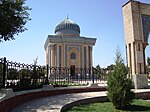Abu al-Hasan al-Bazdawi أبو الحسن البَزدَوي | |
|---|---|
| Title | Fakhr al-Islam فخر الإسلام |
| Personal | |
| Born | 400 A.H. = c. 1010 A.D. |
| Died | 482 A.H.= 1089 A.D. |
| Religion | Islam |
| Era | Islamic Golden Age |
| Region | Transoxiana (Central Asia) |
| Denomination | Sunni |
| Jurisprudence | Hanafi |
| Creed | Maturidi |
| Main interest(s) | Fiqh (Islamic jurisprudence), Usul al-Fiqh |
| Notable work(s) | Usul al-Bazdawi |
| Muslim leader | |
Influenced by
| |
Abu al-Hasan 'Ali ibn Muhammad al-Bazdawi (Arabic: أبو الحسن علي بن محمد البَزدَوي) (c. 1010-1089 A.D.), known with the honorific title of Fakhr al-Islam (the pride of Islam), was a leading Hanafi scholar in the principles of Islamic jurisprudence. He is author of the acclaimed Kanz al-Wusul ila Ma'refat al-Usul (Arabic: کنز الوصول إلی معرفة الأصول, lit. 'The Treasure of Obtaining in Knowledge of Legal'), popularly known as Usul al-Bazdawi, a seminal work in Hanafi Usul al-Fiqh.
'Abd al-Qadir ibn Abi al-Wafa' al-Qurashi (d. 775/1373) has praised him in his Hanafi biographical dictionary, Al-Jawahir al-Mudiyya fi Tabaqat al-Hanafiyya (Arabic: الجواهر المضية في طبقات الحنفية).[1]
Works[edit]
His most famous book is Kanz al-Wusul ila Ma'refat al-Usul (Arabic: کنز الوصول إلی معرفة الأصول), popularly known as Usul al-Bazdawi, which is a seminal book in Hanafi Usul al-Fiqh and was a standard teaching text for centuries.[2]
In this work, he focuses on issues such as rules and methods of determining a variety of sources and methods for making the right decision and discourses on rules of working with texts, and so on. The Uzbek Academy of Sciences has more than a dozen copies of this work.
The book has generated numerous commentaries, the most popular of which being Kashf al-Asrar (Arabic: کشف الأسرار، شرح أصول البزدوي) by 'Abd al-'Aziz al-Bukhari (d. 730/1329).
His other works include:[3]
- Sharh al-Jami' al-Kabeer, and Sharh al-Jami' al-Sagheer (Commentaries on al-Jami' al-Kabeer, and al-Jami' al-Sagheer by Muhammad al-Shaybani).
- Sharh al-Jami' al-Sahih (Commentary on Sahih al-Bukhari).
- Al-Mabsut fi Furu' al-Fiqh (An Extensive Book on Branches of Fiqh).
- Kitab al-Muyassar fi al-Kalam (Elementary Hand-book for Dialectical Theology), a manuscript of which still survives.[4]
He also wrote on Tafsir (Qur'anic exegesis).
Teachers[edit]
Al-Bazdawi studied under Shams al-A'imma 'Abd al-'Aziz al-Halwani (d. 456/1064) who was also a teacher to Al-Sarakhsi.[2]
Students[edit]
- Sadr al-Islam Abu al-Yusr al-Bazdawi (his younger brother)
- Najm al-Din Abu Hafs Umar al-Nasafi
See also[edit]
References[edit]
- ^ Al-Jawahir al-Mudiyya fi Tabaqat al-Hanafiyya, by 'Abd al-Qadir al-Qurashi. January 2005. ISBN 9782745147677.
- ^ a b Hanif, Sohail, 2019, "Al-Hadith al-Mashhur: A Hanafi Reference to Kufan Practice?", in Locating the Shari'a: Legal Fluidity in Theory, History and Practice by Sohaira Siddiqui (ed.), Brill Publications, Leiden, 2019.
- ^ A Brief Biography of Fakhr al-Islam al-Bazdawi. January 2005. ISBN 9782745129833.
- ^ Ahmad Hasan Dani, Vadim Mikhaĭlovich Masson, Clifford Edmund Bosworth (1992). History of Civilizations of Central Asia: The Age of Achievement. Part 2. Unesco. p. 128. ISBN 9789231036545.
{{cite book}}: CS1 maint: multiple names: authors list (link)
| Maturidi scholars |
| |||||||||||||||||||||||||
|---|---|---|---|---|---|---|---|---|---|---|---|---|---|---|---|---|---|---|---|---|---|---|---|---|---|---|
| Theology books | ||||||||||||||||||||||||||
| See also | ||||||||||||||||||||||||||
Maturidi-related templates
| ||||||||||||||||||||||||||

Well, that’s interesting to know that Psilotum nudum are known as whisk ferns. Psilotum nudum is the commoner species of the two. While the P. flaccidum is a rare species and is found in the tropical islands. Both the species are usually epiphytic in habit and grow upon tree ferns. These species may also be terrestrial and grow in humus or in the crevices of the rocks.
View the detailed Guide of Psilotum nudum: Detailed Study Of Psilotum Nudum (Whisk Fern), Classification, Anatomy, Reproduction